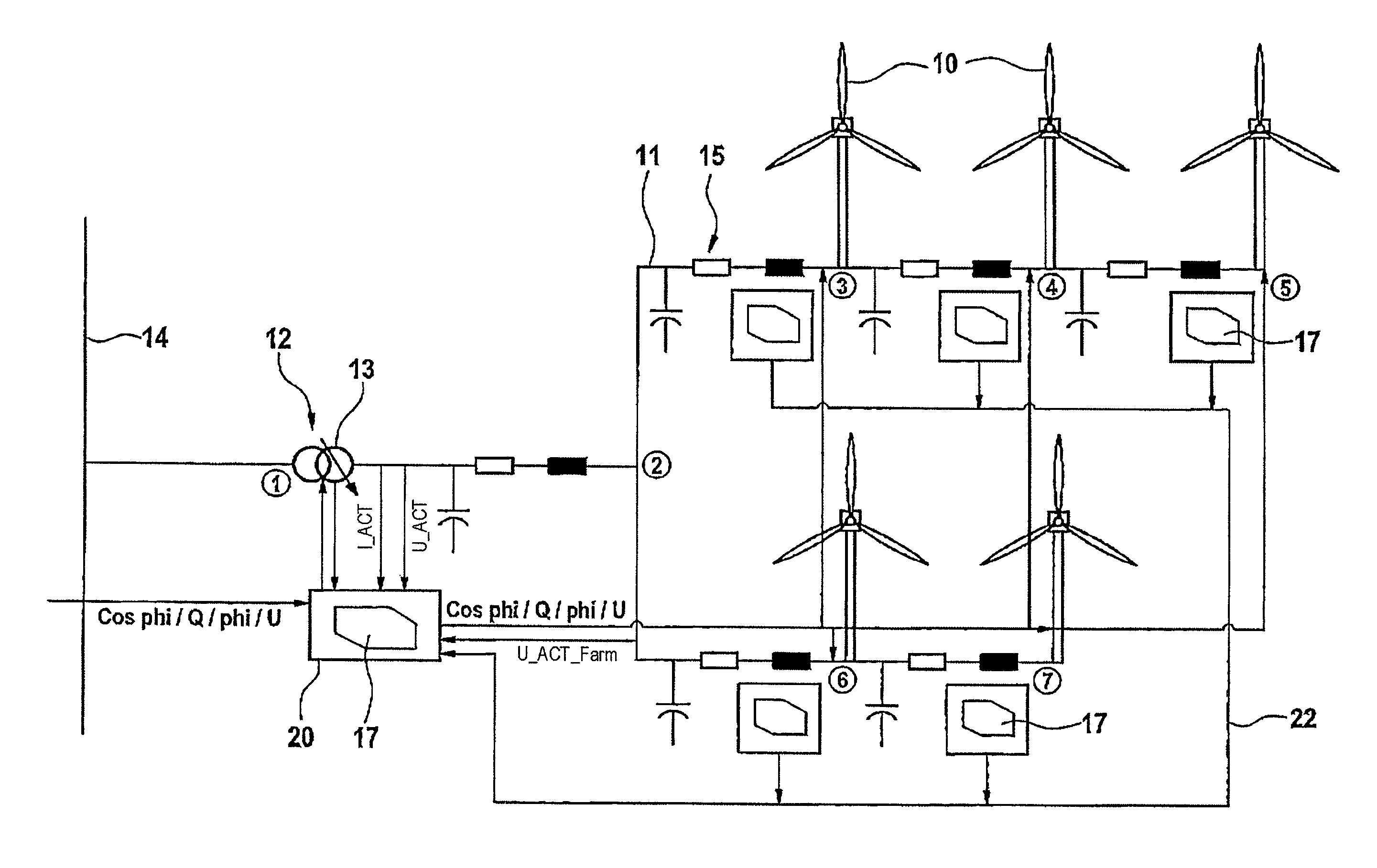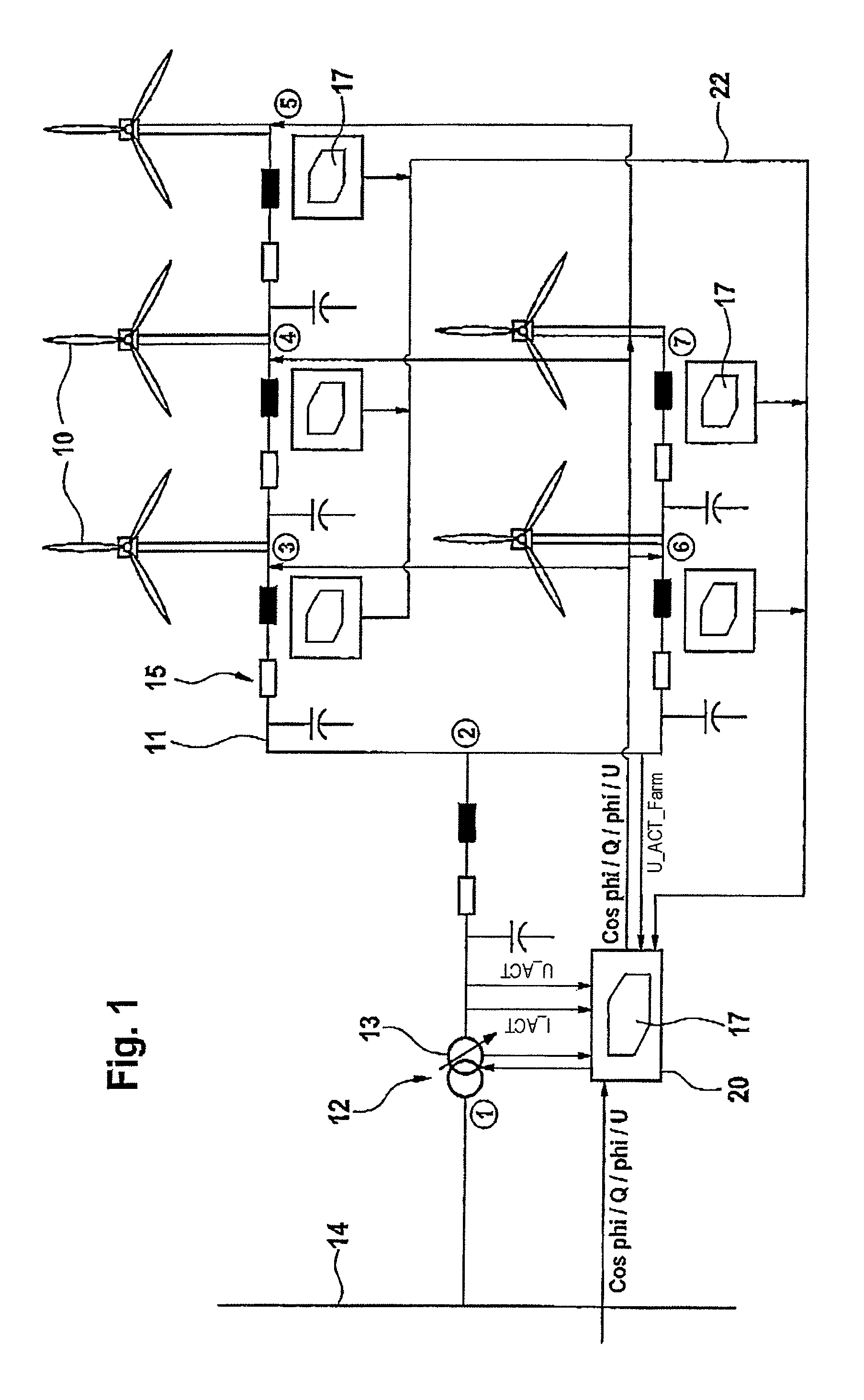[0009]According to the invention, the electrical load level is determined, for example, by considering the
operating point of the wind energy installation and checking the magnitude of the separation between the
operating point and the
system limits of the wind energy installation. For example, if the voltage at the present
operating point is so high there is a
threat of the converter being overloaded, then the operating point is linked to a high electrical load level. In contrast, if the voltage is so low that the electrical components of the wind energy installation, such as the generator, cables, and
transformer are heated by the increased current level, the electrical load level is likewise high. If the electrical load level is found to be high, then the method according to the invention can be used to vary the step-up ratio, which leads to a new voltage being present in the wind-farm-internal network. The wind energy installation can emit the electrical power that is produced at the new voltage, and is therefore at an operating point which is associated with a lower electrical load level. The load on the wind energy installation is reduced.
[0011]If one considers the wind energy installation operating point defined by the voltage U and the wattless component Q, and compares this with the U-Q family of characteristics, then it is possible to use a low electrical load level of the wind energy installation as the basis when the operating point is well away from all the limits of the U-Q family of characteristics. The electrical load level therefore becomes greater as the operating point approaches a limit of the U-Q family of characteristics. When the operating point in this case approaches a limit of the U-Q family of characteristics where one corner is missing in comparison to a rectangle, then the traditional reaction would be to reduce the wattless component Q and accept that the wind energy installation can no longer comply with the wattless component requirement. Instead of this, for the purposes of the invention, the voltage in the wind-farm-internal network can be changed by varying the step-up ratio. The operating point of the wind energy installation is therefore moved away from the limits of the U-Q family of characteristics, and the electrical load level on the wind energy installation is reduced. The freedom obtained in this way can be used to increase the wattless component Q so as to once again comply with the reactive power requirement.
[0016]If the electrical load level on wind energy installations in the wind farm is very high, that is to say the operating point is well away from the desired range, then the
stepping switch can vary the step-up ratio by a plurality of steps in one switching process. Conversely, it need not necessarily be a
precondition for variation of the step-up ratio that one or more wind energy installations is or are reaching its or their
power limits. If the wind energy installations are so far away from their system limits that it is possible to increase the voltage without reaching the system limits, then the voltage increase can be carried out in order to reduce the electrical losses and to increase the efficiency.
[0019]The wind farm according to the invention is designed to carry out the method according to the invention. The invention provides for the wind farm regulation to preset the step-up ratio for the stepping switch as a function of the electrical load level of one wind energy installation. Since the appropriate step-up ratio is preset and the voltage in the wind-farm-internal network is adjusted in this way, the wind energy installations in the wind farm can be operated at an operating point at which the wind energy installations are subject to a
low load.
[0023]The electrical power can first of all be transported via a connecting line to the external network. This is feasible, for example, when the wind farm is an off-
shore wind farm and the electrical power is passed via the connecting line to the coast, or when the wind farm is at a long distance from the closest connection point to the public power distribution network. A first stepping switch can be arranged at a first end of the connecting line, and a second stepping switch at a second end of the connecting line, with the two stepping switches being controlled or regulated by the wind farm
regulator. The voltage in the wind-farm-internal network can in this way be selected independently of the voltage in the public power distribution network, and it is possible to counteract a
voltage drop over the connecting line by switching one of the two stepping switches.
 Login to View More
Login to View More  Login to View More
Login to View More 


